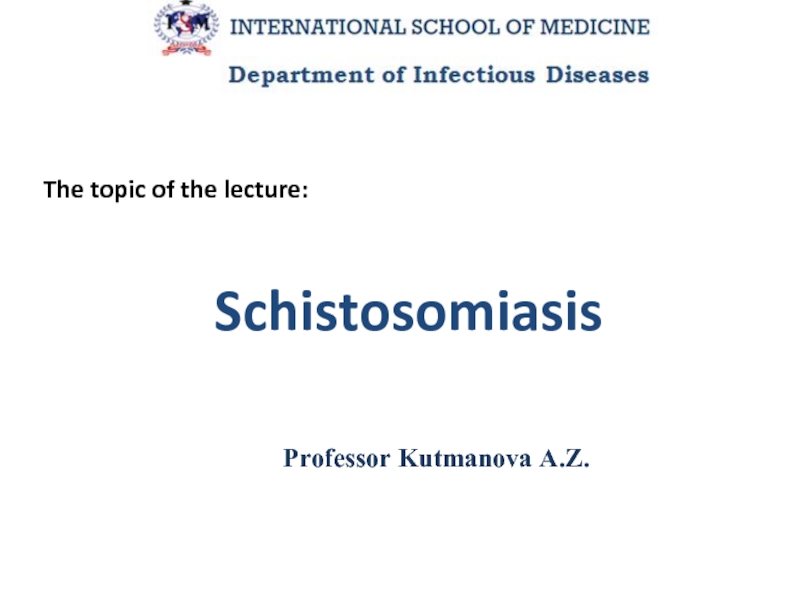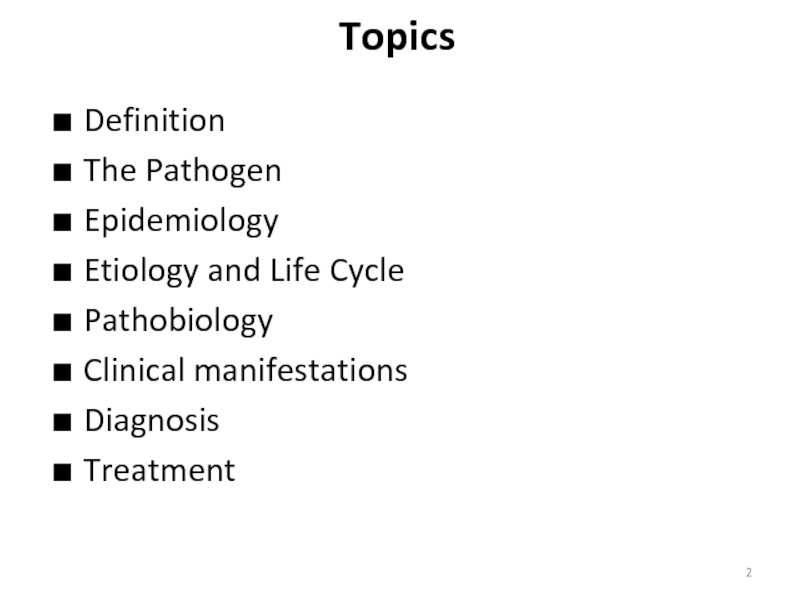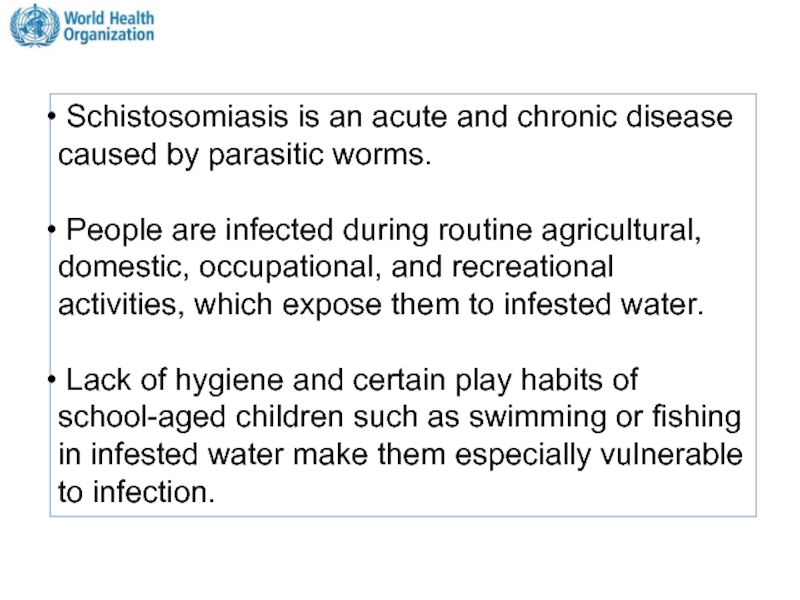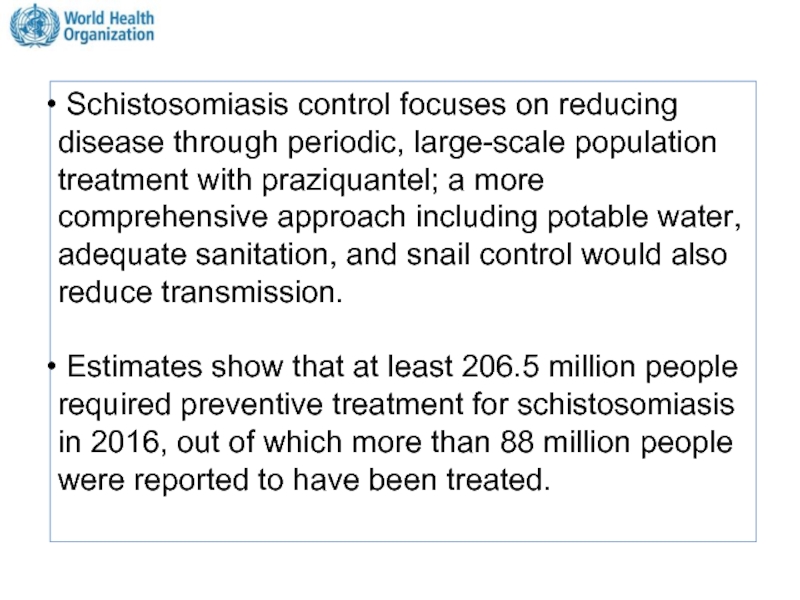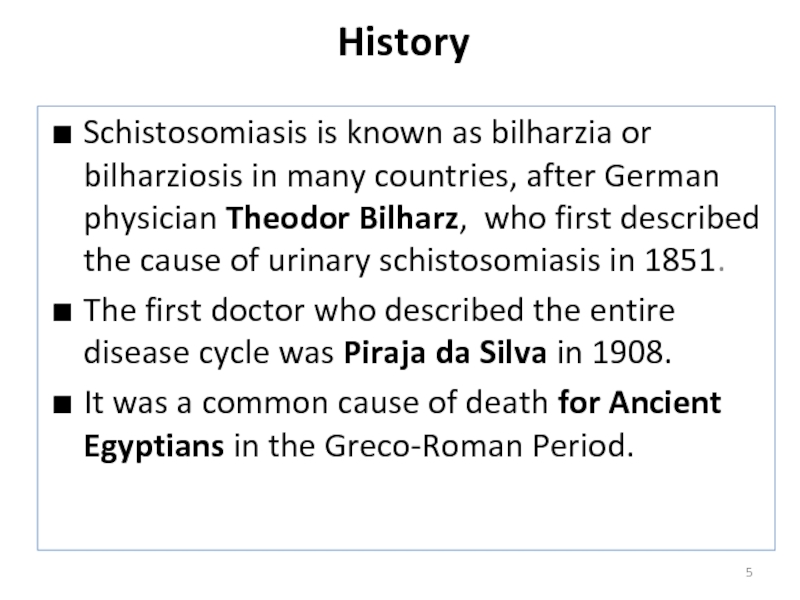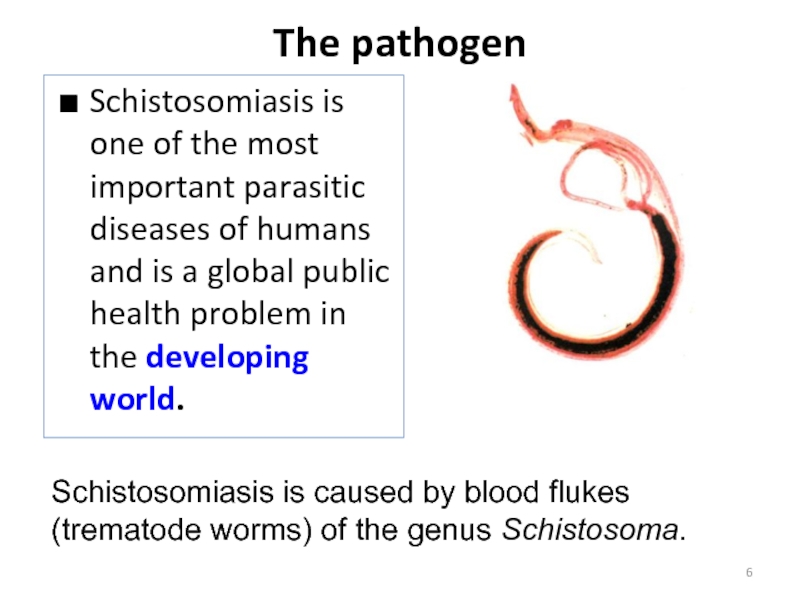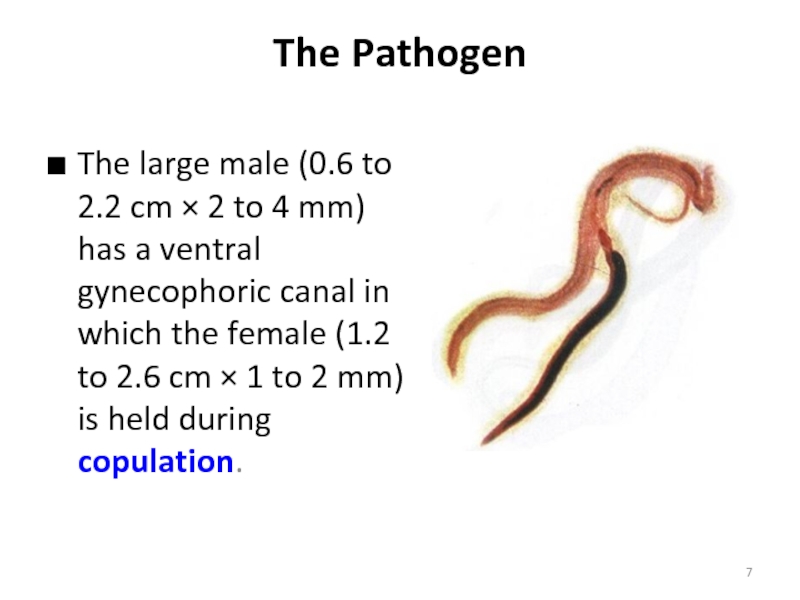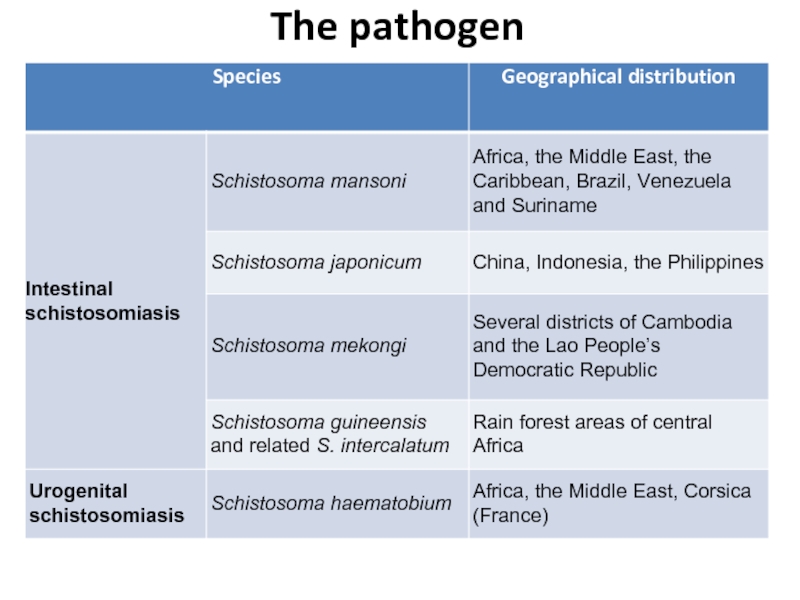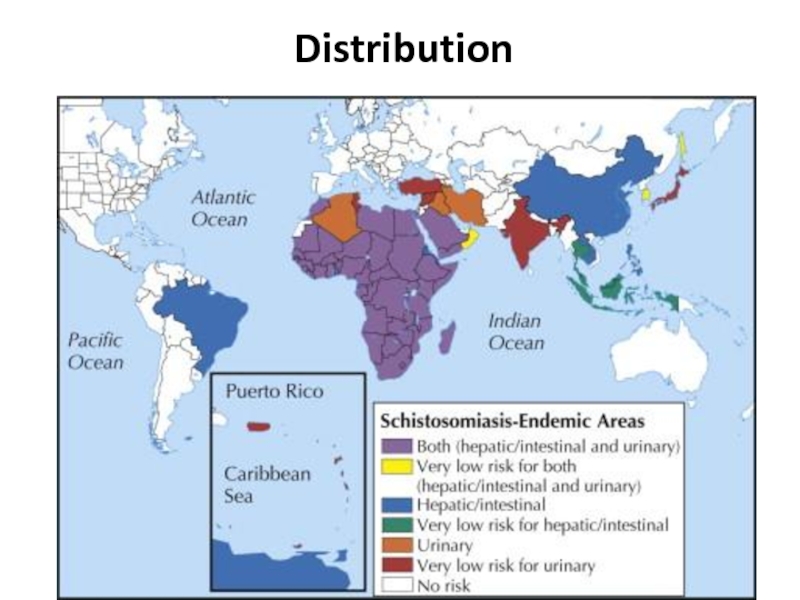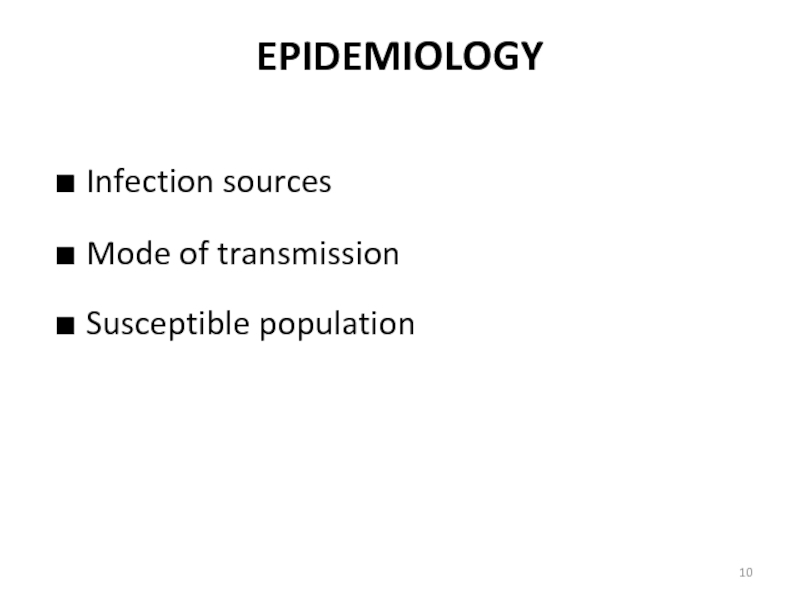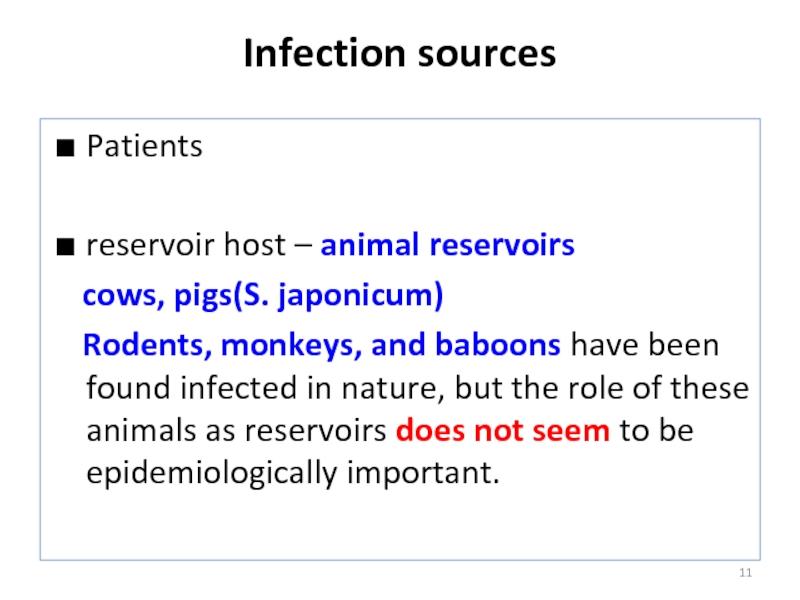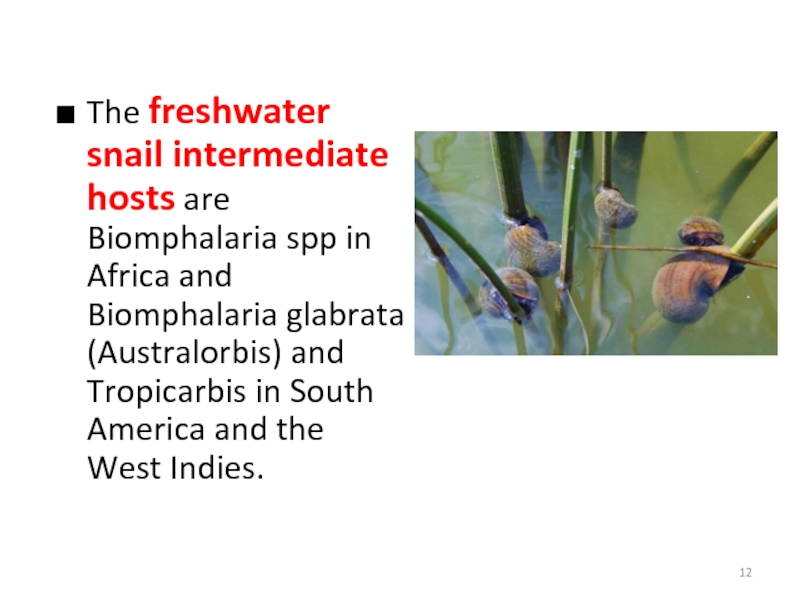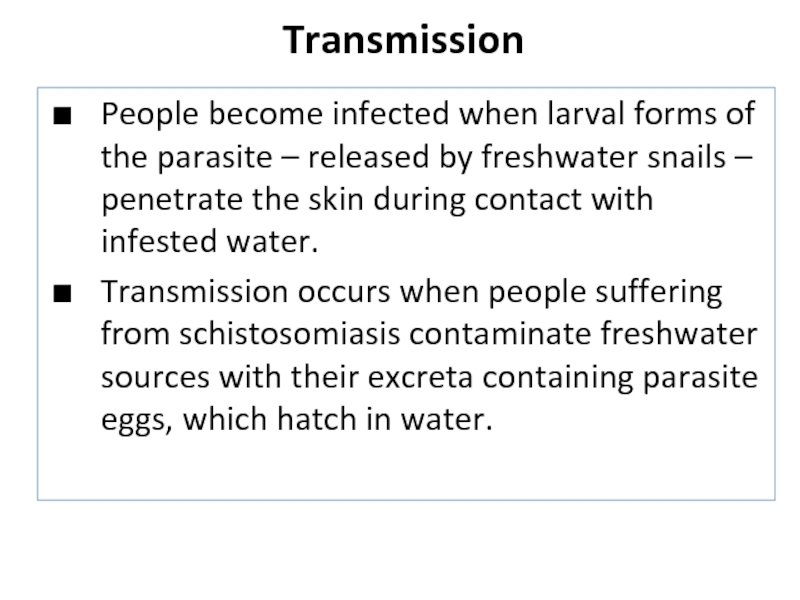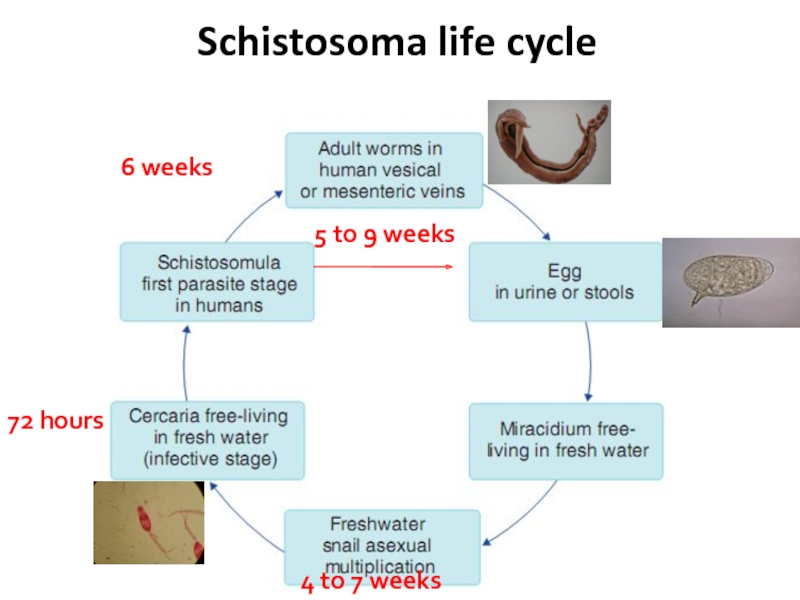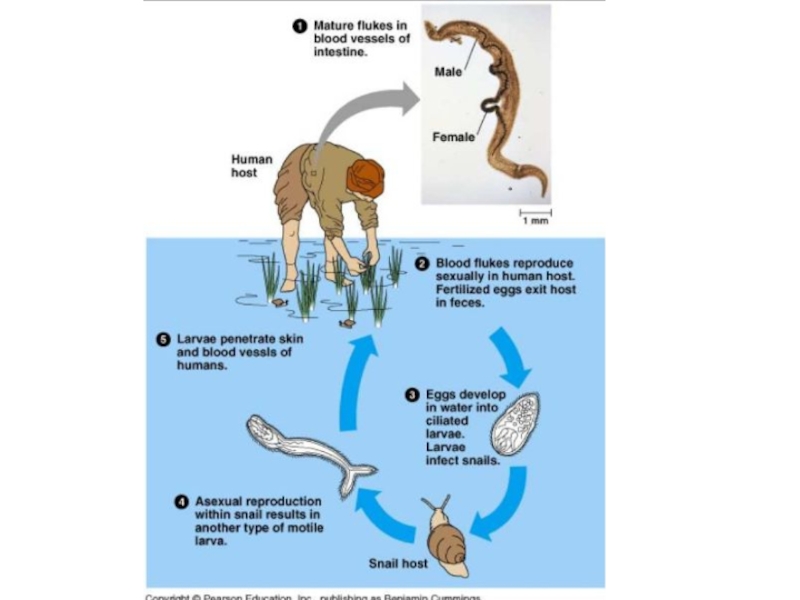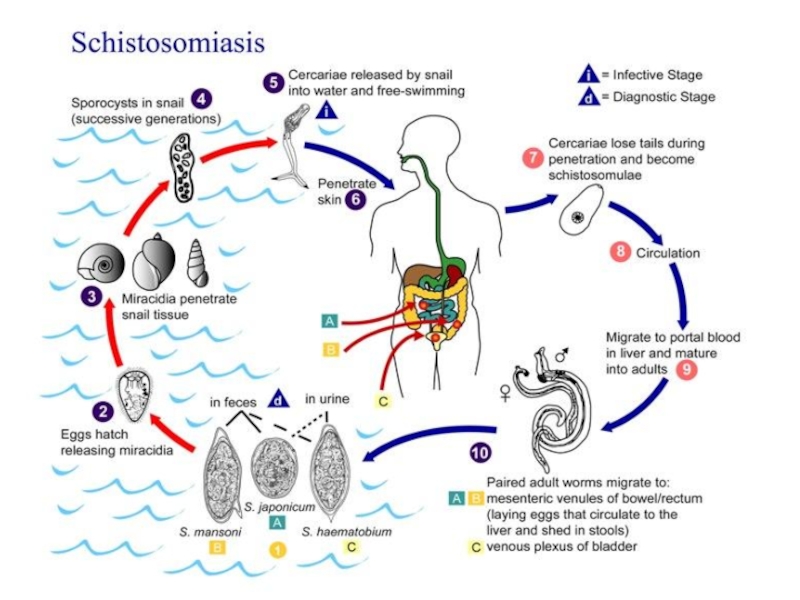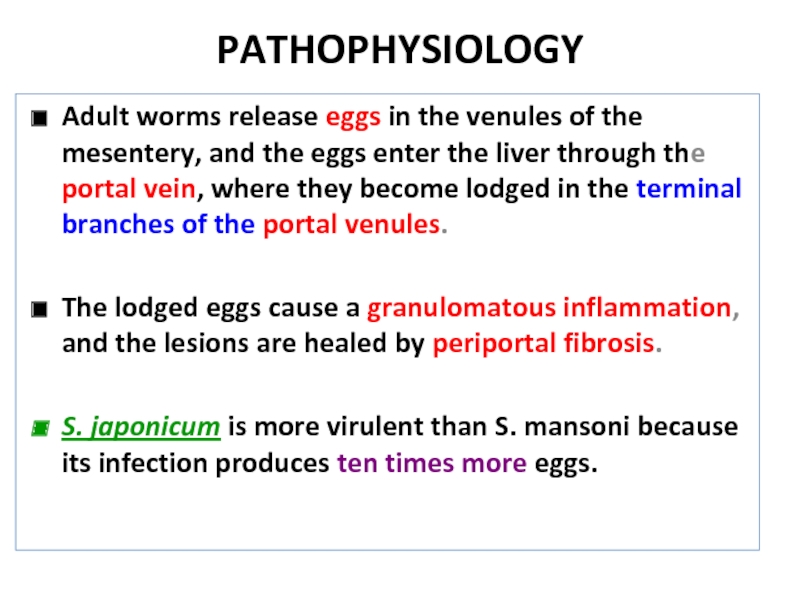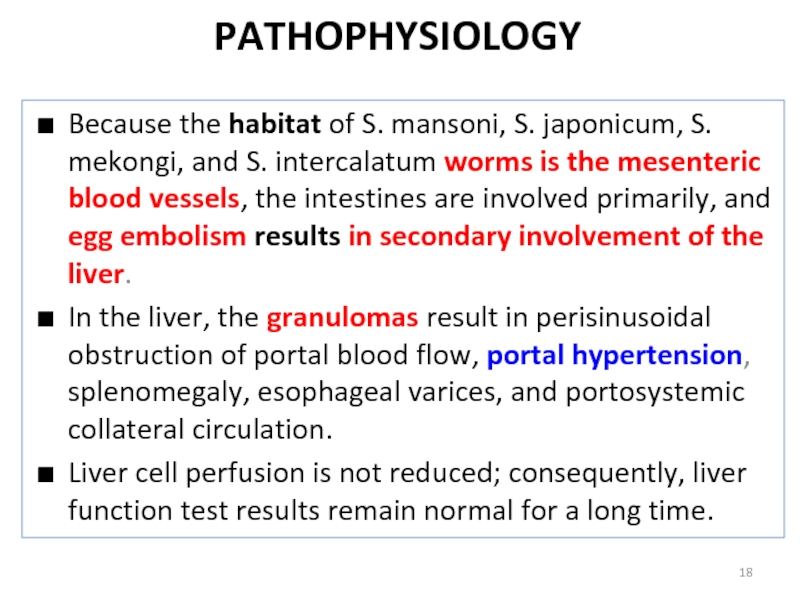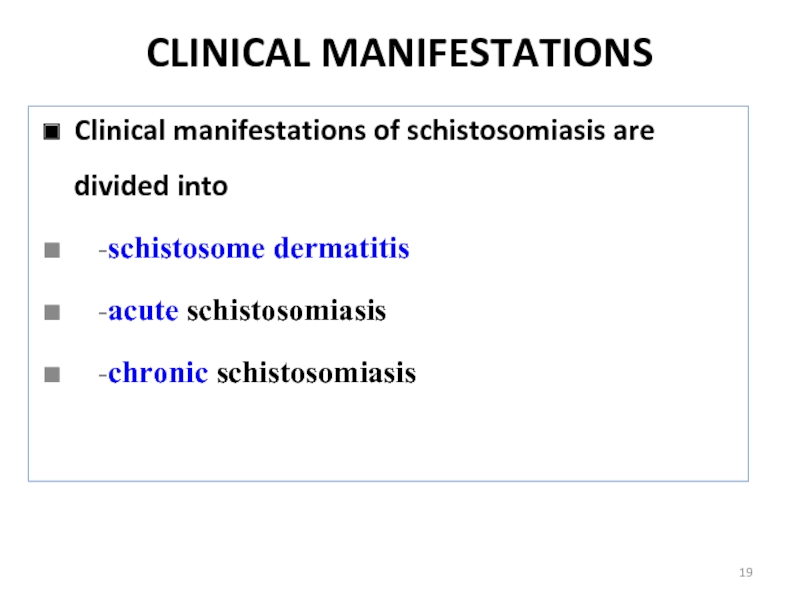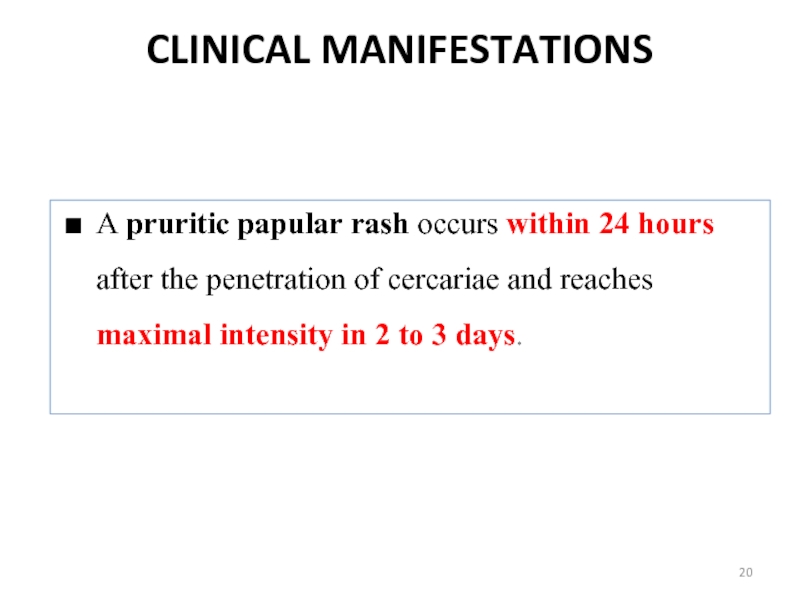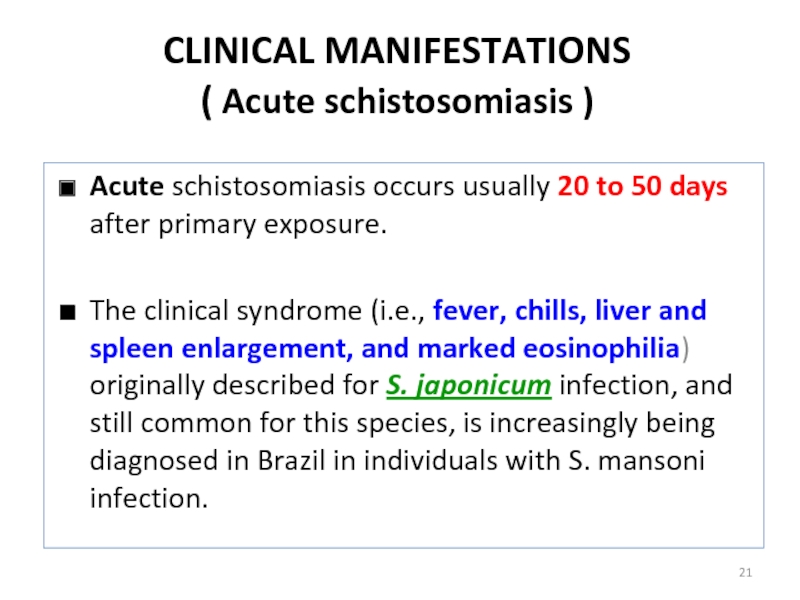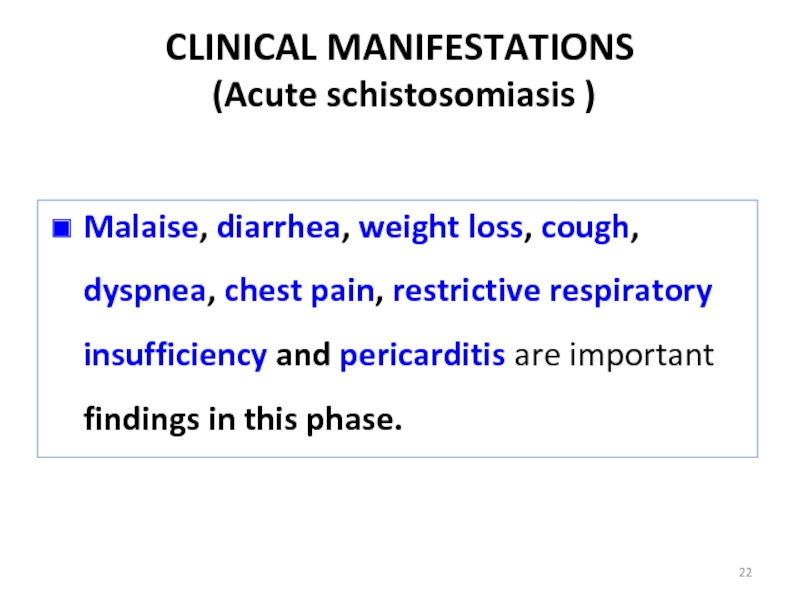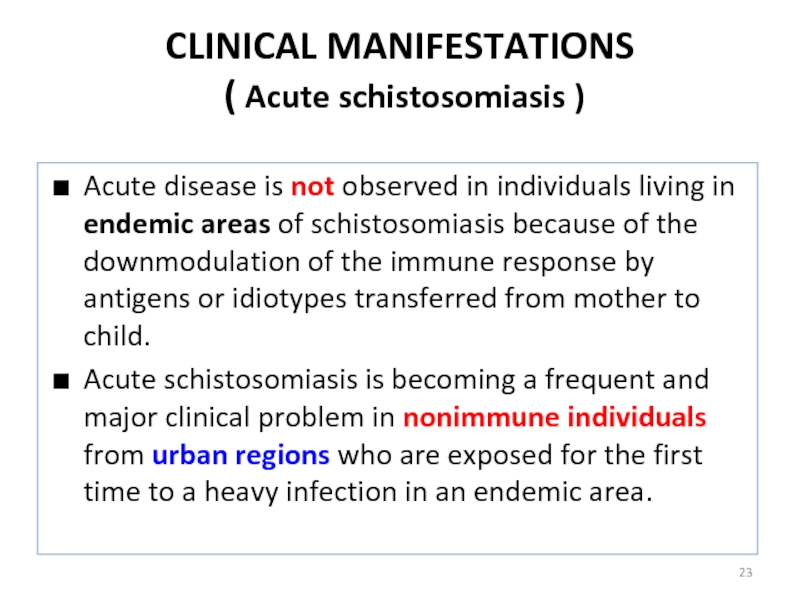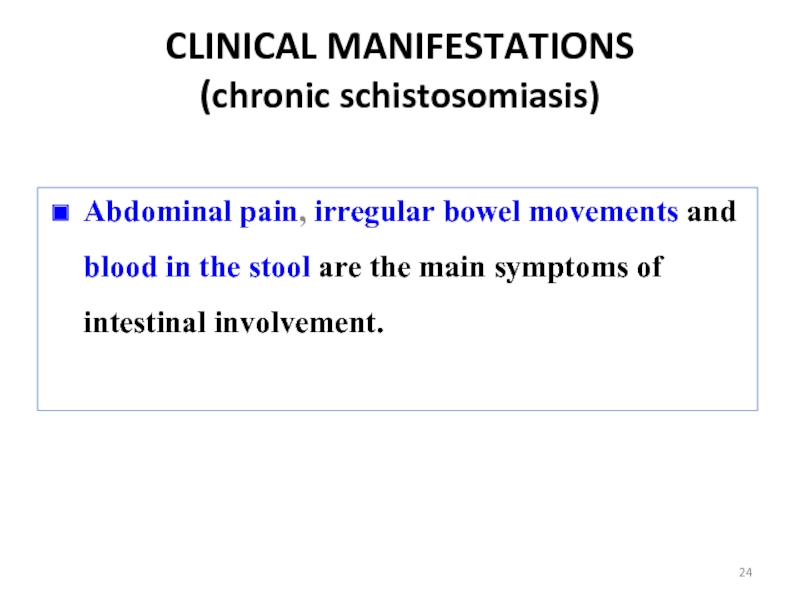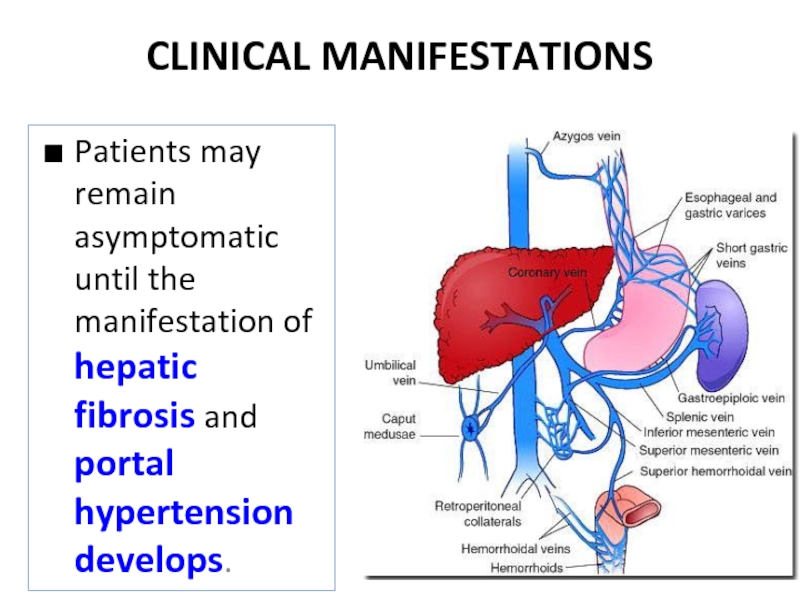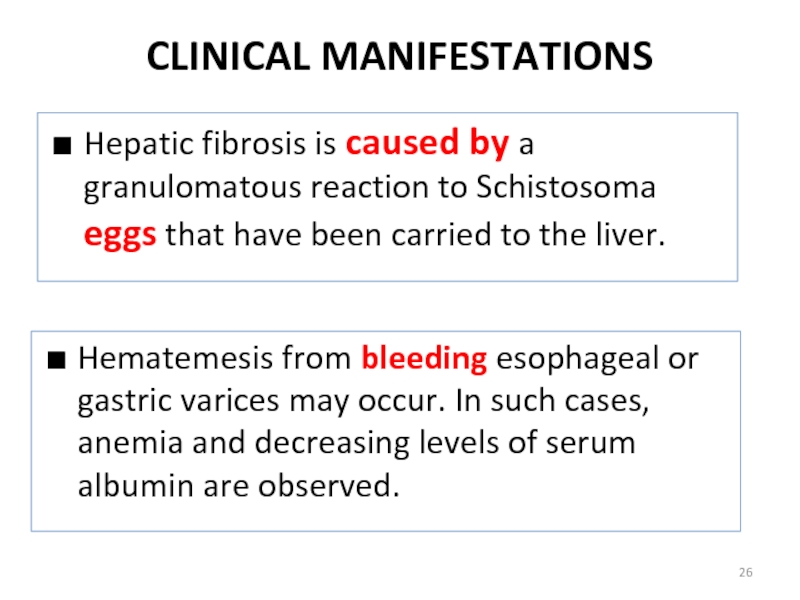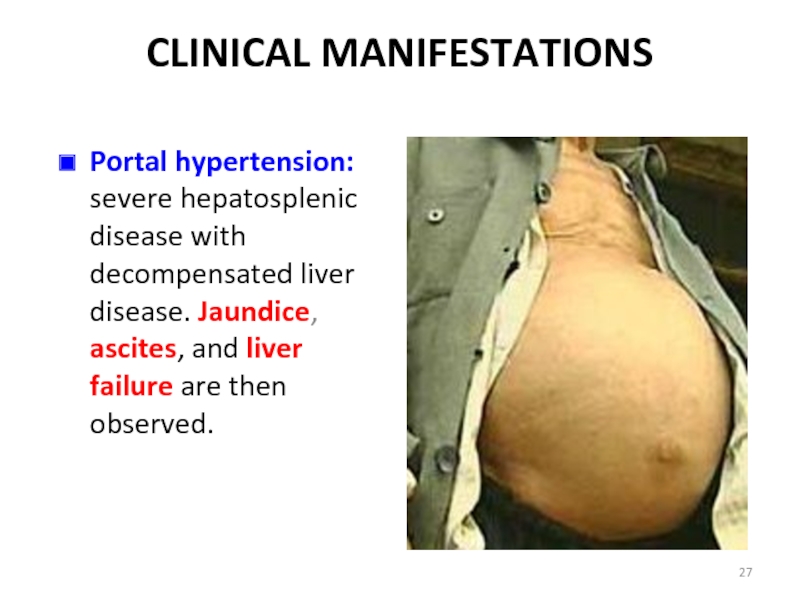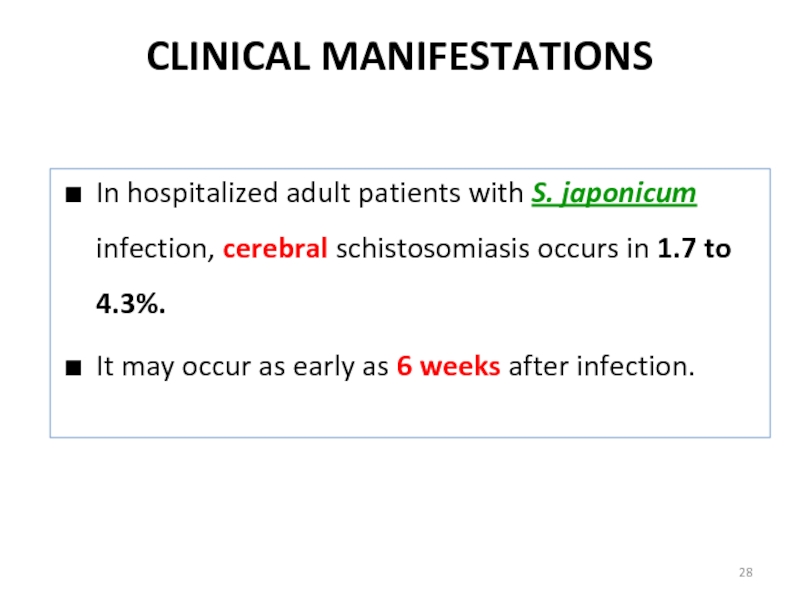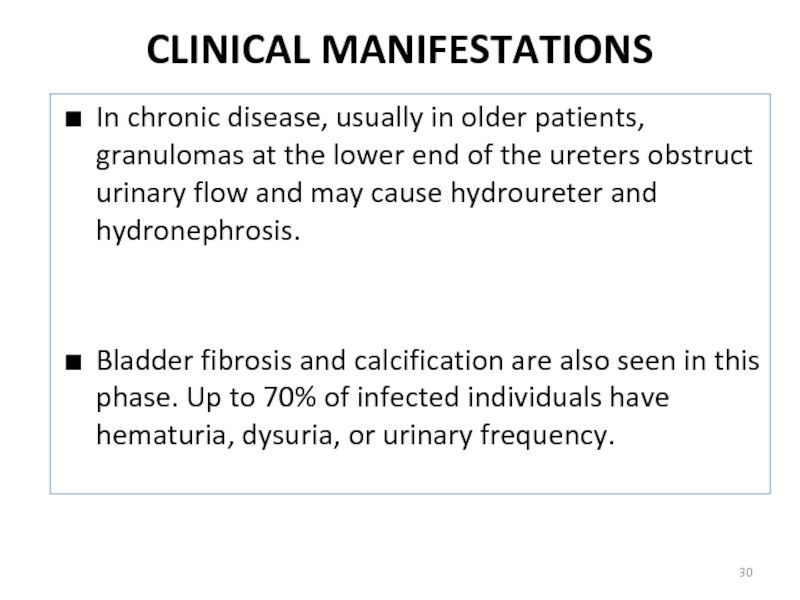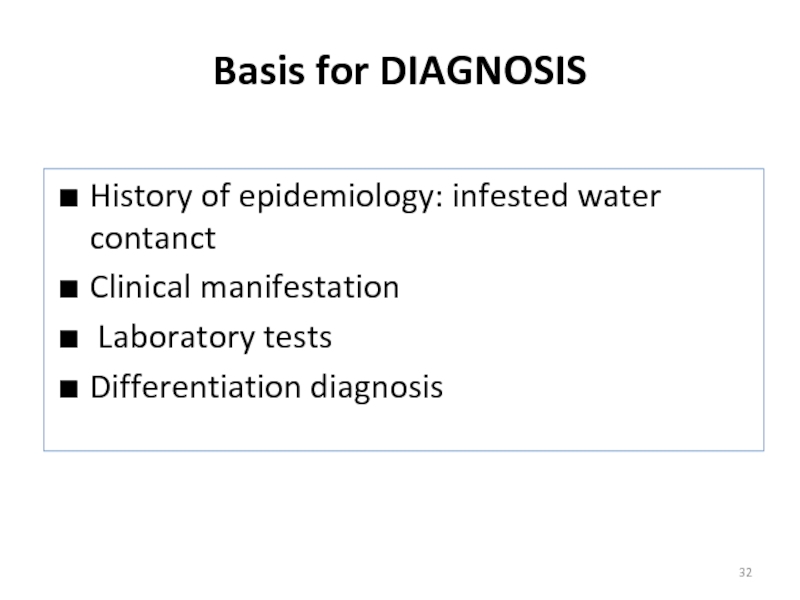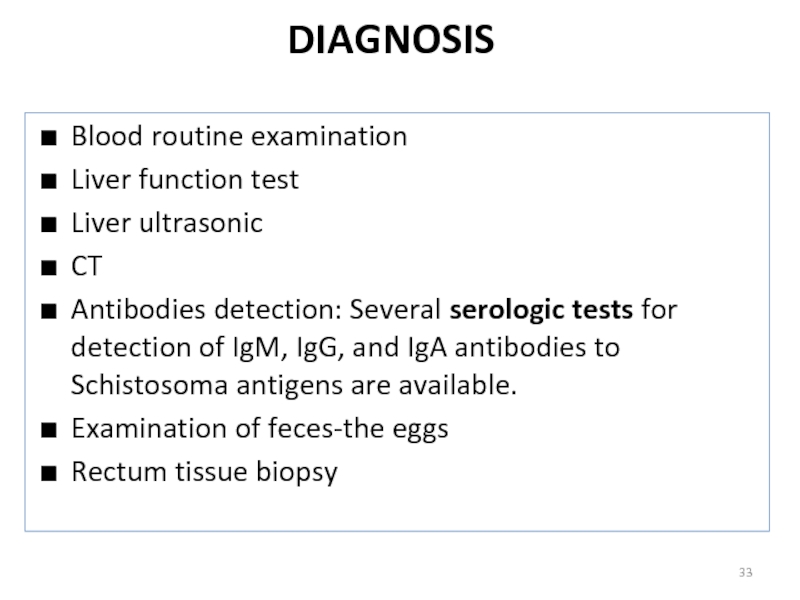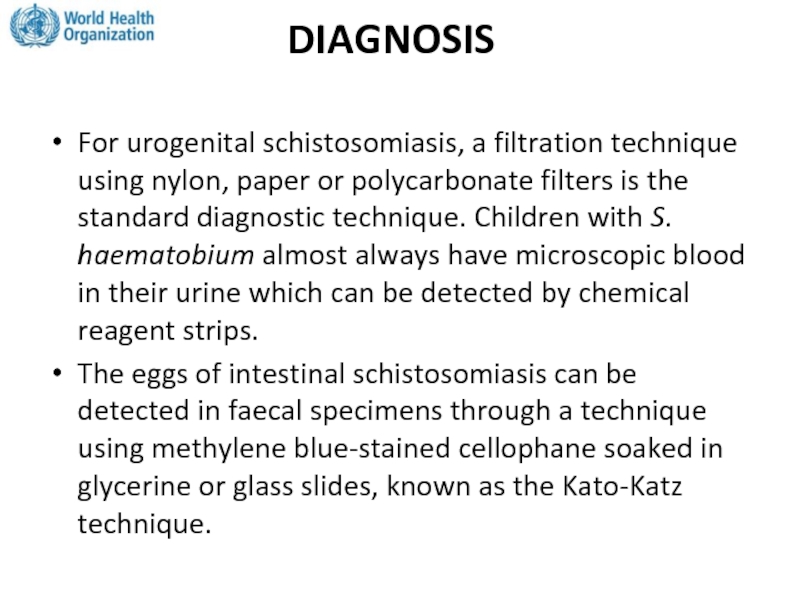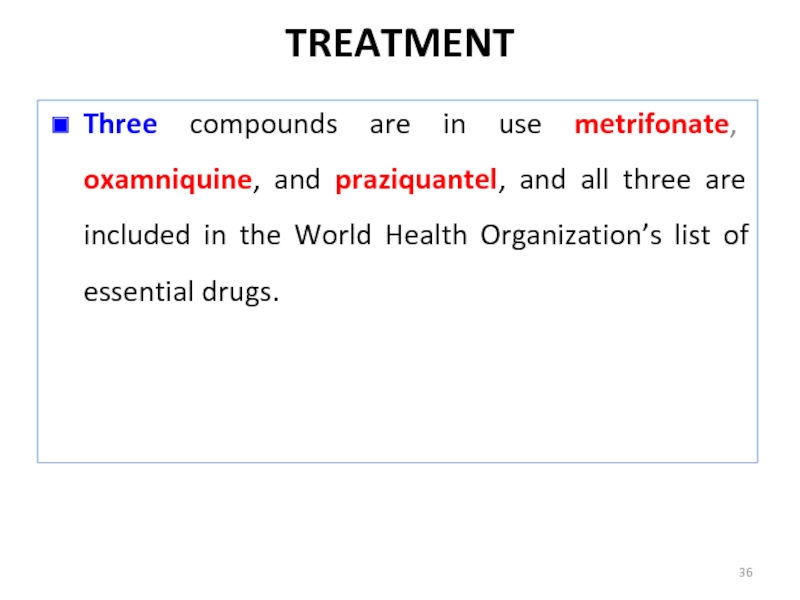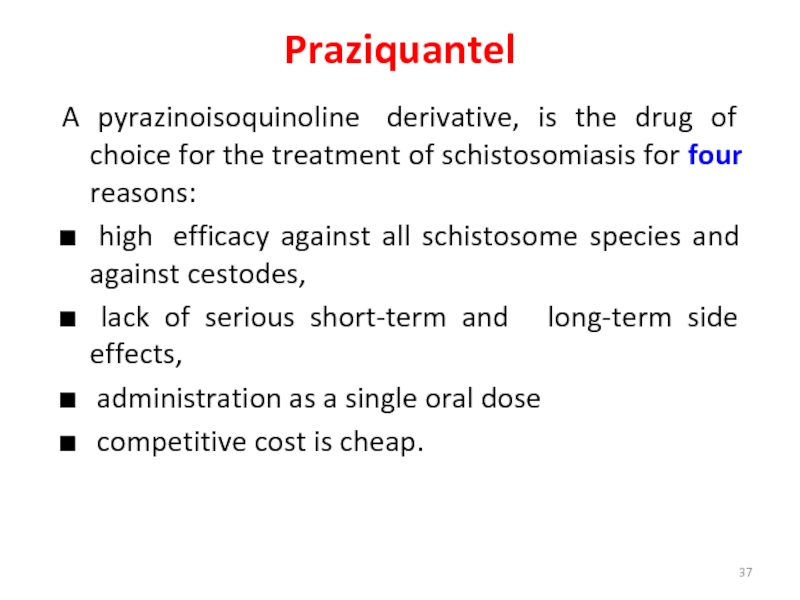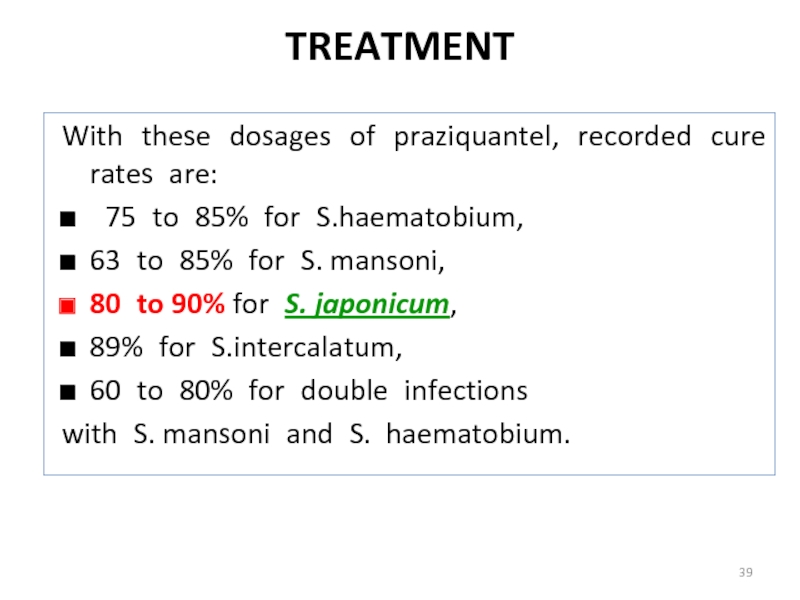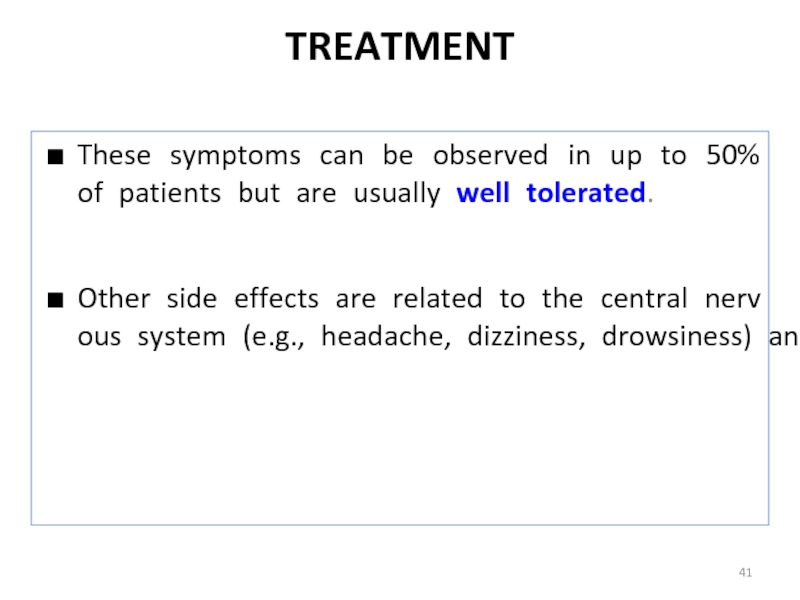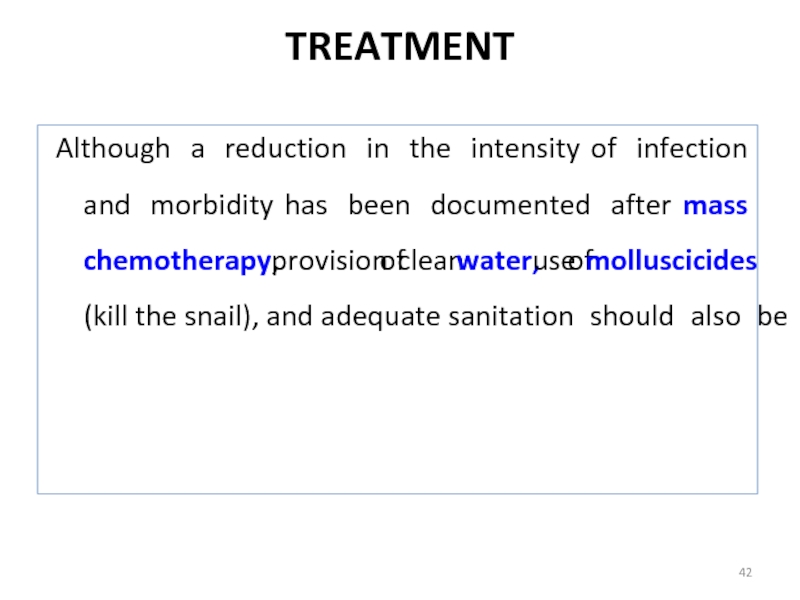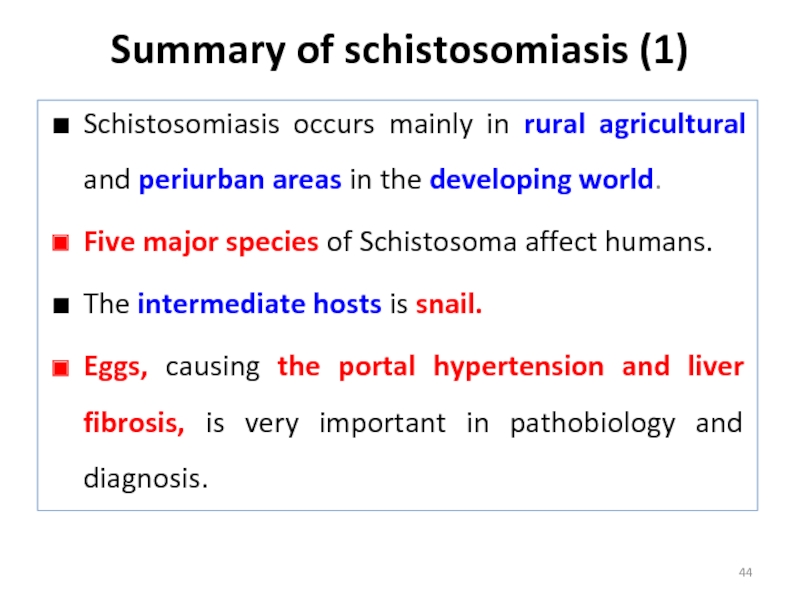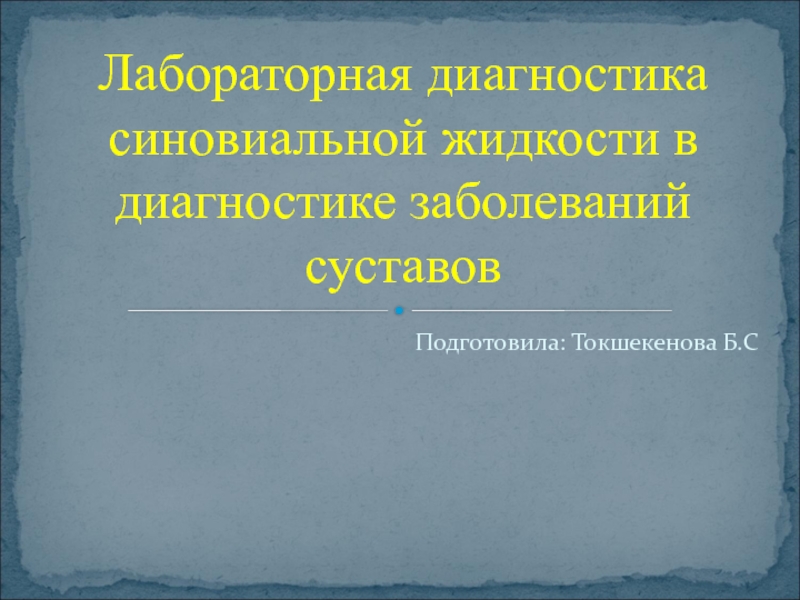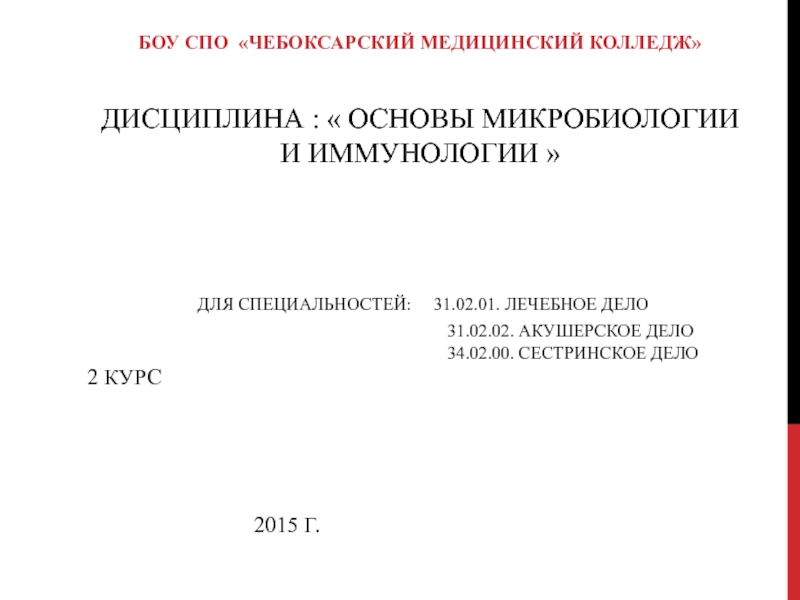- Главная
- Разное
- Дизайн
- Бизнес и предпринимательство
- Аналитика
- Образование
- Развлечения
- Красота и здоровье
- Финансы
- Государство
- Путешествия
- Спорт
- Недвижимость
- Армия
- Графика
- Культурология
- Еда и кулинария
- Лингвистика
- Английский язык
- Астрономия
- Алгебра
- Биология
- География
- Детские презентации
- Информатика
- История
- Литература
- Маркетинг
- Математика
- Медицина
- Менеджмент
- Музыка
- МХК
- Немецкий язык
- ОБЖ
- Обществознание
- Окружающий мир
- Педагогика
- Русский язык
- Технология
- Физика
- Философия
- Химия
- Шаблоны, картинки для презентаций
- Экология
- Экономика
- Юриспруденция
Schistosomiasis презентация
Содержание
- 1. Schistosomiasis
- 2. Topics Definition The Pathogen Epidemiology Etiology and Life Cycle Pathobiology Clinical manifestations Diagnosis Treatment
- 3. Schistosomiasis is an acute and chronic
- 4. Schistosomiasis control focuses on reducing disease
- 5. History Schistosomiasis is known as bilharzia or
- 6. The pathogen Schistosomiasis is one of the
- 7. The Pathogen The large male (0.6 to
- 8. The pathogen
- 9. Distribution
- 10. EPIDEMIOLOGY Infection sources Mode of transmission Susceptible population
- 11. Infection sources Patients reservoir host –
- 12. The freshwater snail intermediate hosts are Biomphalaria
- 13. Transmission People become infected when larval forms
- 14. Schistosoma life cycle 4 to 7 weeks 72 hours 6 weeks
- 17. PATHOPHYSIOLOGY Adult worms release eggs in the
- 18. Because the habitat of S. mansoni, S.
- 19. CLINICAL MANIFESTATIONS Clinical manifestations of schistosomiasis are
- 20. CLINICAL MANIFESTATIONS A pruritic papular rash occurs
- 21. CLINICAL MANIFESTATIONS ( Acute schistosomiasis ) Acute
- 22. CLINICAL MANIFESTATIONS (Acute schistosomiasis ) Malaise,
- 23. CLINICAL MANIFESTATIONS ( Acute schistosomiasis )
- 24. CLINICAL MANIFESTATIONS (chronic schistosomiasis) Abdominal pain, irregular
- 25. CLINICAL MANIFESTATIONS Patients may remain asymptomatic until
- 26. CLINICAL MANIFESTATIONS Hepatic fibrosis is caused by
- 27. CLINICAL MANIFESTATIONS Portal hypertension: severe hepatosplenic disease
- 28. CLINICAL MANIFESTATIONS In hospitalized adult patients with
- 29. CLINICAL MANIFESTATIONS In S. haematobium infection, the
- 30. CLINICAL MANIFESTATIONS In chronic disease, usually in
- 31. CLINICAL MANIFESTATIONS An increased incidence of
- 32. Basis for DIAGNOSIS History of epidemiology: infested
- 33. DIAGNOSIS Blood routine examination Liver function test
- 34. Schistosomiasis is diagnosed through the detection of
- 35. For urogenital schistosomiasis, a filtration technique using
- 36. TREATMENT Three compounds are in use metrifonate,
- 37. Praziquantel A pyrazinoisoquinoline derivative, is the drug of
- 38. TREATMENT The standard recommended treatment consists of a single dose of praziquantel, 40 mg/kg, for S. mansoni, S. haematobium and S. intercalatum infection. In S.japonicum infection, a total dose of 60 mg/kg is recommended, split into two or three doses in a single day. S. mekongi may require two treatments at 60 mg/kg body weight.
- 39. TREATMENT With these dosages of praziquantel, recorded cure rates are: 75 to 85% for S.haematobium, 63 to 85% for S. mansoni, 80 to 90% for S. japonicum, 89% for S.intercalatum, 60 to 80% for double infections with S. mansoni and S. haematobium.
- 40. TREATMENT The most common side effects observed with praziquantel or oxamniquine are related to the gastrointestinal tract: abdominal pain or discomfort, nausea, vomiting, anorexia, and diarrhea.
- 41. TREATMENT These symptoms can be observed in up to 50% of patients but are usually well tolerated. Other side effects are related to the central nervous system (e.g., headache, dizziness, drowsiness) and the skin (e.g., pruritus, eruptions) or may be nonspecific (e.g., fever, fatigue).
- 42. TREATMENT Although a reduction in the intensity of infection and morbidity has been documented after mass chemotherapy, provision of clean water, use of molluscicides (kill the snail), and adequate sanitation should also be implemented to control the disease.
- 43. TREATMENT The mortality rate is 0.05% for severe S. mansoni infection and 1.8% for severe S.japonicum infection. Bleeding from esophageal varices is the most serious complication. Chronic infection can lead to hepatocellular carcinoma.
- 44. Summary of schistosomiasis (1) Schistosomiasis occurs mainly
- 45. Summary of schistosomiasis(2) Metrifonate, oxamniquine, and praziquantel
Слайд 2Topics
Definition
The Pathogen
Epidemiology
Etiology and Life Cycle
Pathobiology
Clinical manifestations
Diagnosis
Treatment
Слайд 3 Schistosomiasis is an acute and chronic disease caused by parasitic
People are infected during routine agricultural, domestic, occupational, and recreational activities, which expose them to infested water.
Lack of hygiene and certain play habits of school-aged children such as swimming or fishing in infested water make them especially vulnerable to infection.
Слайд 4 Schistosomiasis control focuses on reducing disease through periodic, large-scale population
Estimates show that at least 206.5 million people required preventive treatment for schistosomiasis in 2016, out of which more than 88 million people were reported to have been treated.
Слайд 5History
Schistosomiasis is known as bilharzia or bilharziosis in many countries, after
The first doctor who described the entire disease cycle was Piraja da Silva in 1908.
It was a common cause of death for Ancient Egyptians in the Greco-Roman Period.
Слайд 6The pathogen
Schistosomiasis is one of the most important parasitic diseases of
Schistosomiasis is caused by blood flukes (trematode worms) of the genus Schistosoma.
Слайд 7The Pathogen
The large male (0.6 to 2.2 cm × 2 to
Слайд 11Infection sources
Patients
reservoir host – animal reservoirs
cows, pigs(S. japonicum)
Слайд 12The freshwater snail intermediate hosts are Biomphalaria spp in Africa and
Слайд 13Transmission
People become infected when larval forms of the parasite – released
Transmission occurs when people suffering from schistosomiasis contaminate freshwater sources with their excreta containing parasite eggs, which hatch in water.
Слайд 17PATHOPHYSIOLOGY
Adult worms release eggs in the venules of the mesentery, and
The lodged eggs cause a granulomatous inflammation, and the lesions are healed by periportal fibrosis.
S. japonicum is more virulent than S. mansoni because its infection produces ten times more eggs.
Слайд 18Because the habitat of S. mansoni, S. japonicum, S. mekongi, and
In the liver, the granulomas result in perisinusoidal obstruction of portal blood flow, portal hypertension, splenomegaly, esophageal varices, and portosystemic collateral circulation.
Liver cell perfusion is not reduced; consequently, liver function test results remain normal for a long time.
PATHOPHYSIOLOGY
Слайд 19CLINICAL MANIFESTATIONS
Clinical manifestations of schistosomiasis are divided into
-schistosome
-acute schistosomiasis
-chronic schistosomiasis
Слайд 20CLINICAL MANIFESTATIONS
A pruritic papular rash occurs within 24 hours after the
Слайд 21CLINICAL MANIFESTATIONS
( Acute schistosomiasis )
Acute schistosomiasis occurs usually 20 to 50
The clinical syndrome (i.e., fever, chills, liver and spleen enlargement, and marked eosinophilia) originally described for S. japonicum infection, and still common for this species, is increasingly being diagnosed in Brazil in individuals with S. mansoni infection.
Слайд 22CLINICAL MANIFESTATIONS
(Acute schistosomiasis )
Malaise, diarrhea, weight loss, cough, dyspnea, chest
Слайд 23CLINICAL MANIFESTATIONS
( Acute schistosomiasis )
Acute disease is not observed in
Acute schistosomiasis is becoming a frequent and major clinical problem in nonimmune individuals from urban regions who are exposed for the first time to a heavy infection in an endemic area.
Слайд 24CLINICAL MANIFESTATIONS
(chronic schistosomiasis)
Abdominal pain, irregular bowel movements and blood in the
Слайд 25CLINICAL MANIFESTATIONS
Patients may remain asymptomatic until the manifestation of hepatic fibrosis
Слайд 26CLINICAL MANIFESTATIONS
Hepatic fibrosis is caused by a granulomatous reaction to Schistosoma
Hematemesis from bleeding esophageal or gastric varices may occur. In such cases, anemia and decreasing levels of serum albumin are observed.
Слайд 27CLINICAL MANIFESTATIONS
Portal hypertension: severe hepatosplenic disease with decompensated liver disease. Jaundice,
Слайд 28CLINICAL MANIFESTATIONS
In hospitalized adult patients with S. japonicum infection, cerebral schistosomiasis
It may occur as early as 6 weeks after infection.
Слайд 29CLINICAL MANIFESTATIONS
In S. haematobium infection, the main organ system involved is
The acute granulomatous response to parasite eggs in the early stages causes urinary tract disease, such as urethral ulceration and bladder polyposis.
Слайд 30CLINICAL MANIFESTATIONS
In chronic disease, usually in older patients, granulomas at the
Bladder fibrosis and calcification are also seen in this phase. Up to 70% of infected individuals have hematuria, dysuria, or urinary frequency.
Слайд 31CLINICAL MANIFESTATIONS
An increased incidence of squamous cell carcinoma of the
S. haematobium eggs have occasionally been found in the lungs, with subsequent focal pulmonary arteritis and pulmonary hypertension.
Слайд 32Basis for DIAGNOSIS
History of epidemiology: infested water contanct
Clinical manifestation
Laboratory tests
Differentiation
Слайд 33DIAGNOSIS
Blood routine examination
Liver function test
Liver ultrasonic
CT
Antibodies detection: Several serologic tests for
Examination of feces-the eggs
Rectum tissue biopsy
Слайд 34Schistosomiasis is diagnosed through the detection of parasite eggs in stool
Antibodies and/or antigens detected in blood or urine samples are also indications of infection.
DIAGNOSIS
Слайд 35For urogenital schistosomiasis, a filtration technique using nylon, paper or polycarbonate
The eggs of intestinal schistosomiasis can be detected in faecal specimens through a technique using methylene blue-stained cellophane soaked in glycerine or glass slides, known as the Kato-Katz technique.
DIAGNOSIS
Слайд 36TREATMENT
Three compounds are in use metrifonate, oxamniquine, and praziquantel, and all
Слайд 37Praziquantel
A pyrazinoisoquinoline derivative, is the drug of choice for the treatment of
high efficacy against all schistosome species and against cestodes,
lack of serious short-term and long-term side effects,
administration as a single oral dose
competitive cost is cheap.
Слайд 38TREATMENT
The standard recommended treatment consists of a single dose of praziquantel, 40 mg/kg, for S. mansoni, S. haematobium and S. intercalatum infection.
In S.japonicum infection, a total dose of 60 mg/kg is recommended, split into two or three doses in a single day.
S. mekongi may require two treatments at 60 mg/kg body weight.
Слайд 39TREATMENT
With these dosages of praziquantel, recorded cure rates are:
75 to 85% for S.haematobium,
63 to 85% for S. mansoni,
80 to 90% for S. japonicum,
89% for S.intercalatum,
60 to 80% for double infections
with S. mansoni and S. haematobium.
Слайд 40TREATMENT
The most common side effects observed with
praziquantel or oxamniquine are related to the gastrointestinal tract: abdominal pain or discomfort, nausea, vomiting, anorexia, and diarrhea.
Слайд 41TREATMENT
These symptoms can be observed in up to 50% of patients but are usually well tolerated.
Other side effects are related to the central nervous system (e.g., headache, dizziness, drowsiness) and the skin (e.g., pruritus, eruptions) or may be nonspecific (e.g., fever, fatigue).
Слайд 42TREATMENT
Although a reduction in the intensity of infection and morbidity has been documented after mass chemotherapy, provision of clean water, use of molluscicides (kill the snail), and adequate
Слайд 43TREATMENT
The mortality rate is 0.05% for severe S. mansoni infection and 1.8% for severe S.japonicum infection.
Bleeding from esophageal varices is the most
serious complication.
Chronic infection can lead to hepatocellular
carcinoma.
Слайд 44Summary of schistosomiasis (1)
Schistosomiasis occurs mainly in rural agricultural and periurban
Five major species of Schistosoma affect humans.
The intermediate hosts is snail.
Eggs, causing the portal hypertension and liver fibrosis, is very important in pathobiology and diagnosis.
Слайд 45Summary of schistosomiasis(2)
Metrifonate, oxamniquine, and praziquantel are included in the WHO’s
Praziquantel is well tolerated and effective for different clinical forms of schistosomiasis.
